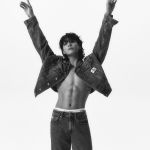
The recent case of a Calvin Klein poster deemed as “inappropriate”
Re-opens the debate on the thin line between morale and image in fashion
March 22nd, 2017
Just a few weeks ago we talked about the ban against Saint Laurent's campaign, accused to be offensive against women, and today we are debating a similar issue. This time it's Calvin Klein at the center of the controversy because of its recent underwear campaign, deemed inappropriate and irresponsible. The image in question appeared on the window of House of Fraser store in Cheltenham, shows model Lulu while she seems intent on taking her basic Calvin Klein bra. The store has received so many attacks that it has been forced to remove that advertising billboard. People accuse not only the “flirty” pose of the model but the fact she seems to be underage – even if she is over 18.
"While I realise it is likely she is probably of legal age to appear, the fact that she looks underage in terms of body shape and somewhat vulnerable facial expression combined with the fact that she is wearing very little and is adopting a strangely provocative pose means it could be deemed to sexualise children" a spokeswoman of the prosecution said.
So, the advertising is deemed dangerous because it sends an ambiguous and irresponsible message. The fact that the model is actually over 18 doesn't matter, because what the ad shows is a very young girl in a racy pose, creating a very sexual image.
#1 Sex sells
It's not the first time that Calvin Klein does a campaign like that. The story of the brand is full of billboards who play with erotism, with ambiguous and naughty messages or openly race. And it's not surprising that a campaign of the brand has been banned because deemed as inappropriate. So, why does it continue to do it? Excepting the fact that this style is now an identifying mark for the brand, the answer is simple: sex sells. In fashion, and not only that, a certain kind of erotic language helps to capture more audience.
And this is (also) the reason why Calvin Klein plays with teenager-models, naughty poses and semi-erotic images – the recent campaign with Kendall Jenner is a good example. Even in 1995, the brand was at the center of a controversy because of his campaign for a jeans collection, deemed as ambiguous – the video showed very young models interviewed by a voice-over who seemed to recreate the scenery of an amateur hard video.
#2 Other banned campaigns
But Calvin Klein is not the only one who adopted this visual language for its advertising campaigns. Except for the most prominent case of American Apparel, who turned the Pop Lolita style into its trademark, many other brands have chosen very young models for their campaigns, facing the same fate of the American brand.
In 2011 the campaign for Marc Jacobs's fragrance Oh Lola!, with Dakota Fanning as star and shot by Juergen Teller, was accused of being too provocative for the young actress – even if she openly defended those shots time after. In the same year, Miu Miu removed his campaign for the Fall/Winter season with Hailee Steinfeld because deemed as “irresponsible” for showing a kid alone on the railroad tracks. Some years later, the Miuccia Prada's brand was back at the center of a controversy because of its campaign with actress Mia Goth, accused to have “inappropriately sexualising a model who appeared to be a child”. In fact, the ad shows the 22-years-old model lying in bed and looking at the camera, creating a voyeuristic and very sensual scenery.
#3 Can fashion advertising be misleading?
The question is: are these advertising really dangerous? Are they really offensive for who looks at them? Can they be a bad example or send inappropriate messages? It's hard to give an answer. The child sexual exploitation is a real problem and the fact that fashion often “uses” their image by playing with Lolita-like tones or making the line between teenager and adult confusing is not a good job.
However, there is the risk to turn censorship into fashion advertising into a useless witch hunt, making billboard as new scapegoat to punish to ease our consciousness.
Moreover, if it's true that ASA “Advertising Standards Authority” reflects and protects the ideas of public opinion, it's not always true that it's right. Namely, just because many people consider an image as inappropriate, it doesn't mean it really is. And moreover, how far censorship against fashion advertising can go? Don't we take the risk to make compatible standards too strict? Finally, we must not underestimate a certain “miseducation” of people to fashion advertising language. And don't want to defend every type of publicity, but often we forget that advertising photography can be considered an art of which we have to learn its languages.

























































